This is the third and final post in my small series chronicling an “experimental archaeology” project of mine about 18th century alteration practices by first making then altering a 1760s style gown to a 1780s style gown drawing upon research from my PhD thesis on the topic. If you’re just joining and would like to start from the beginning you can click for Part 1 and Part 2.
This reveal has ended up being a tease for some of you since it took some time for me to get pictures that I was really happy with. I hope it won’t be too anti-climactic for you! For the first photoshoot of the 1780s dress I ended up being unhappy with my styling of the gown – hair, ruffles, ribbon colours. It took time to schedule a re-shoot, which Taylor of Dames a la Mode was very gracious to do for me (she took the styled photos of the 1760s gown and the first round of the 1780s dress – she has a lot of patience with me, for which I am very grateful!).
And now, without further ado, I present to you the altered gown:
Phase 3: 1780s dress
Plain Photos
The first set of photos are just the gown mostly alone but with the proper underpinnings for the 1780s, mainly a split false rump in addition to the stays, rather than the pocket hoops worn for the 1760s iteration.
With the skirt left un-tied at the back:
With the skirt tied up at back:
“Fashion” Photos
For styling, I paired the altered gown with a neckline ruffle, sleeve ruffles and petticoat I made to go with my pale blue cutaway-front anglaise last year (the neckline ruffle was a later addition to the ensemble). I had made these pieces specifically to be moved from gown to gown and I love that I’ve actually been doing that!
The green ribbons are from Dames a la Mode and I’m so pleased with how well they set of and contrast against the pink of the gown making the whole ensemble look so fresh – perfect for spring!
Note in the photo above how the re-pleating of the skirt has shifted the pocket slits towards the back of the body – this was a very common feature I found amongst extant garments altered for the 4th quarter of the century.
In the photo below you can see the effect of the narrowed ‘en fourreau’ pleats and can also see some hints of stitching and crease lines from the previous configuration.
A detail of the extended sleeves:
The silk organza cap was made using the American Duchess guide to 18th century Dressmaking and I think it’s so wonderfully frilly and froofy!
Details of the stitched-down sleeve head pleats that create the effect of a slightly more smoothly fitting sleeve without making major alterations to the sleeve.
Combined, the alterations and different accessories/styling really create such a different look compared with the 1760s version!
Some extra photos because I think they’re pretty!
Ok, so not the best photo for illustrating the project but I love the mood of it:
Haha, I kind of feel like I’m in some sort of advertisement in this one:
Direct Comparisons
Showing the two versions side-by-side really highlights the change in style and aesthetic between the two periods!
Of the plain gown:
1760s 1780s
Of the styled gown:
Findings/Thoughts
A quick summary of my findings and ruminations on the project as a whole and its outcome:
- I was surprised to find that the work proceeded more quickly than anticipated. The entire alterations process was completed within 3 days. A period seamstress/mantuamaker who performed this kind of work regularly would sure have been able to execute even more quickly. This, combined with the low cost of labour in the period really did make altering one’s gowns a very easy and economical option
- Along with the above, I continued to be struck by how a very different look could be achieved with relatively little time, difficulty, labour, and extra materials.
- From the initial making of the gown and petticoat I had some scraps left over, these were more than enough to provide what I needed to perform the alterations; they would also have been sufficient should more piecing of the bodice fronts been required. Since customers bought their own fabric and brought it to the mantuamaker the inevitable leftover scraps actually belonged to the customer and were often kept by them expressly for future maintenance and re-modelling.
- I was pleased (and relieved, lol!) to see that the types of stitch and crease marks left from the alterations I made were similar to those I observed on extant garments. So this helped to support my theories of the methods by which at least some mid-century gowns were altered for the 4th quarter of the century – always gratifying!
- The 1760s gown was made according to construction methods and processes used in the period as closely as I was able and I found they were well designed to facilitate un-picking and efficient re-making. This is an aspect of 18th century dressmaking that has intrigued me for years, since my MA research days. I even termed the overall approach to 18th century dressmaking as “made to be unmade” (TM ;oP) For years I’ve theorized that not only were alterations expected but that the specific types of stitches and seams used on different parts of the garment were carefully calculated to combine efficiency of making, durability (where needed), and ease of un-picking/re-making. It was such a treat to actually utilize these features!
- I was really excited by one particular “aha” moment – I noticed that the deepening of the back bodice point was a necessary result of the alteration, this also became a style trend of the 1780s, leading me to wonder if this particular alteration may have actually fuelled the fashion trend/tendency. And if this was the case, are there other instances where the natural consequence of an alteration might have done the same/similar? It was also really neat to have another little tidbit to help complicate the “on the ground” practice of fashion in the 18th century, how fashion plates – beautiful and inspirational/aspirational as they are – do not necessarily represent what even the fashionable among society actually did.
And so there you have it folks! I’m happy to answer any questions about this project that you might have and would love to hear your thoughts if it sparks any! Thanks so much for coming on this ride with me!



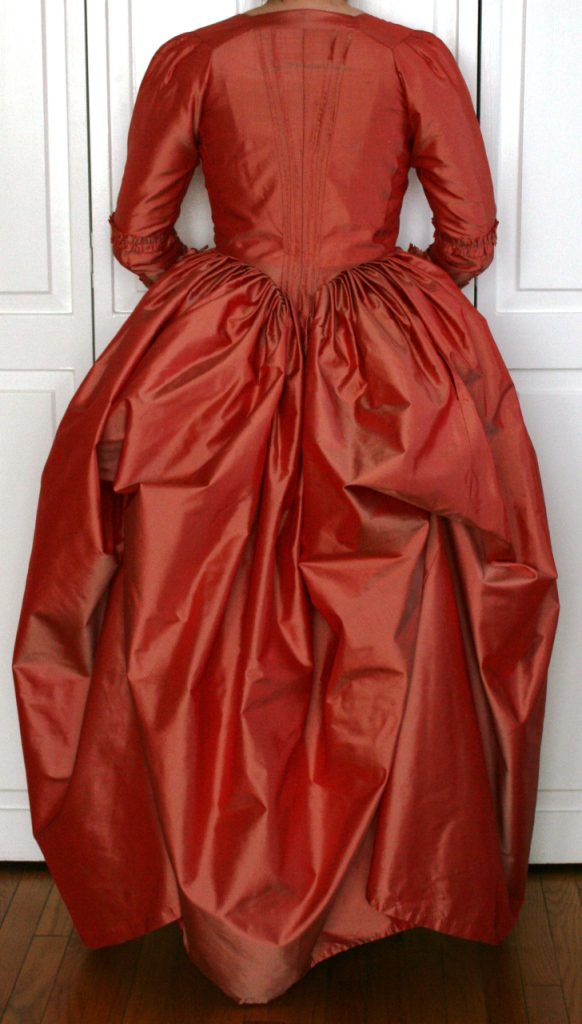





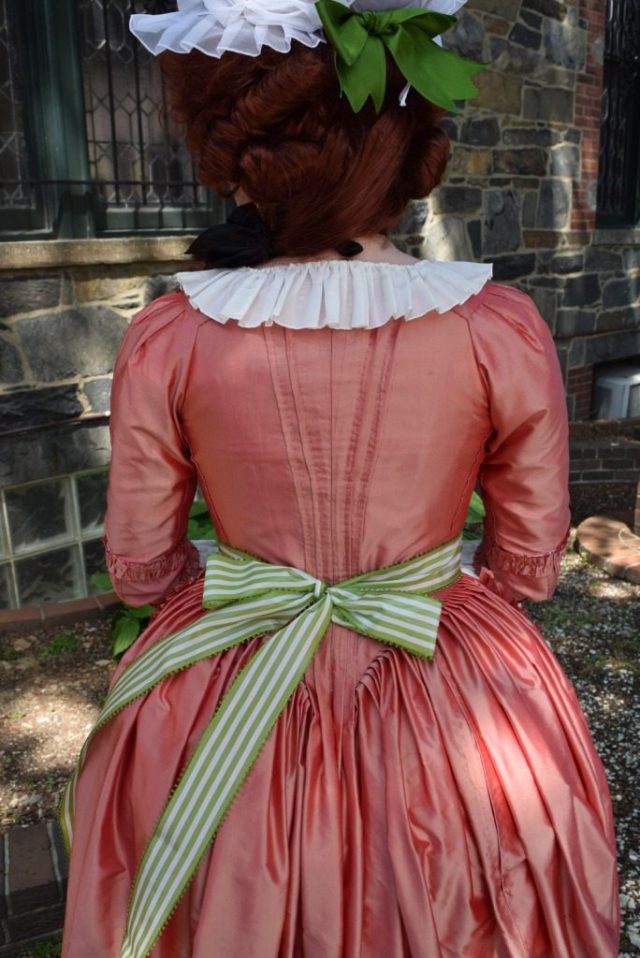

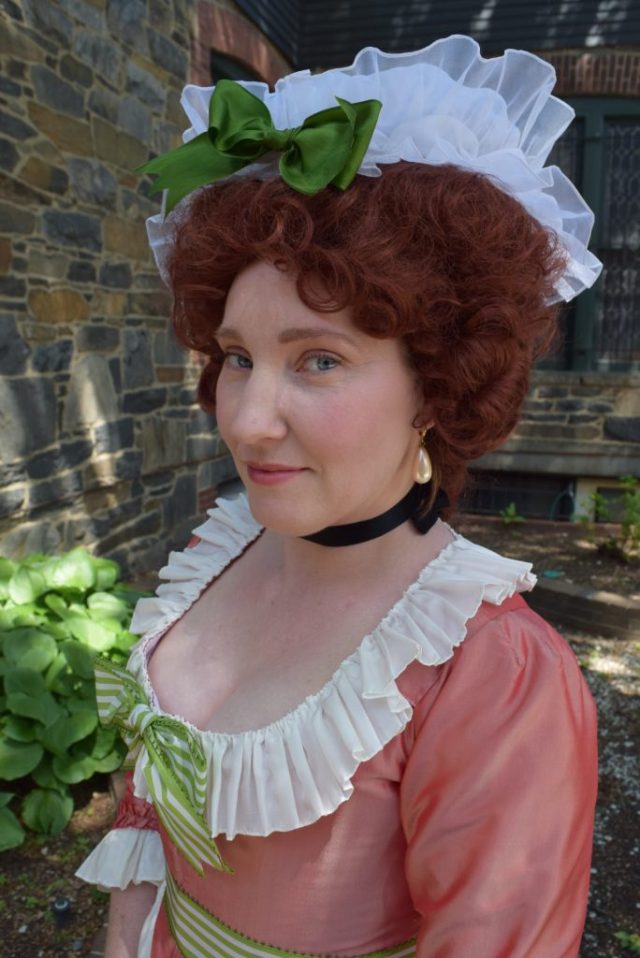

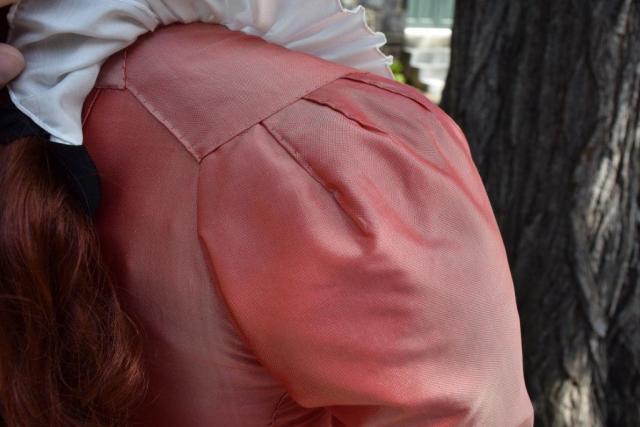


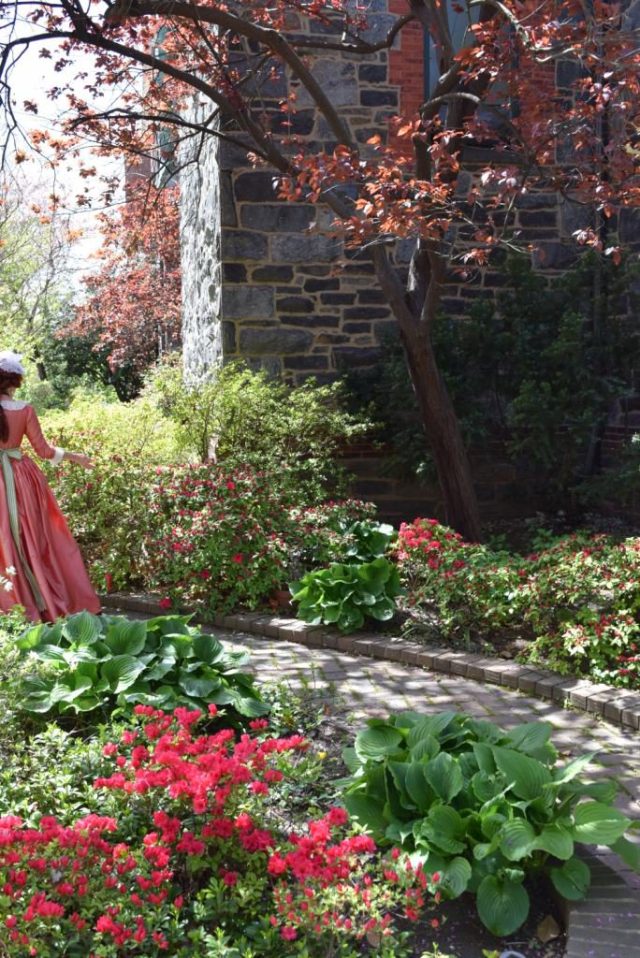
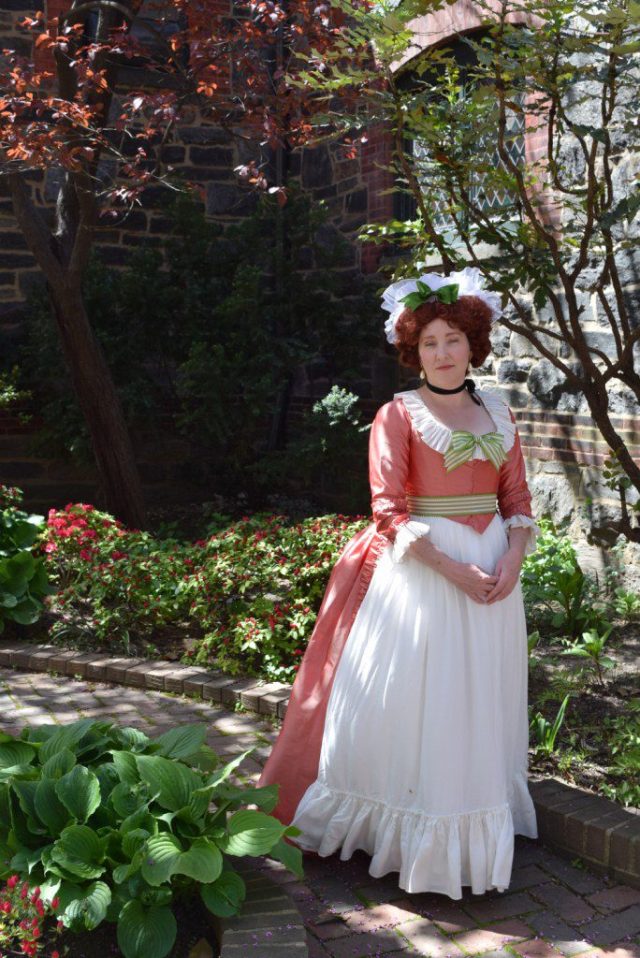

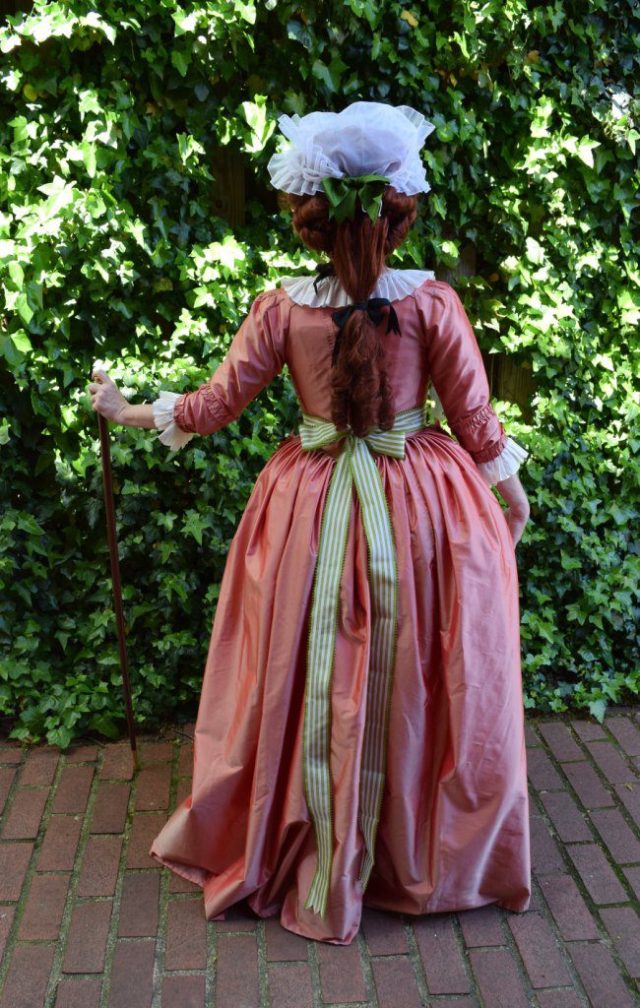

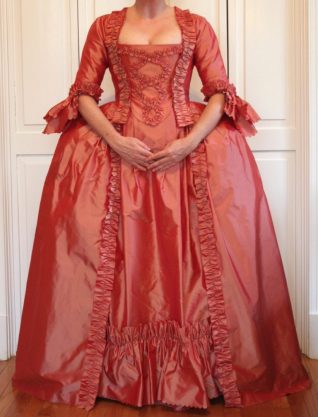
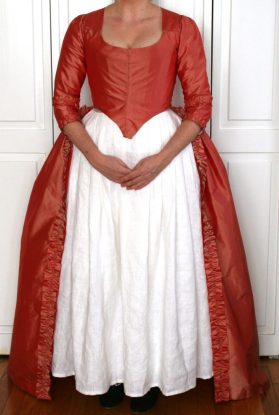


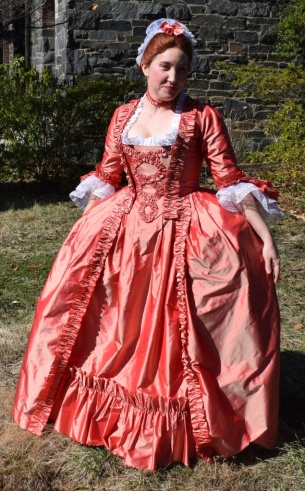
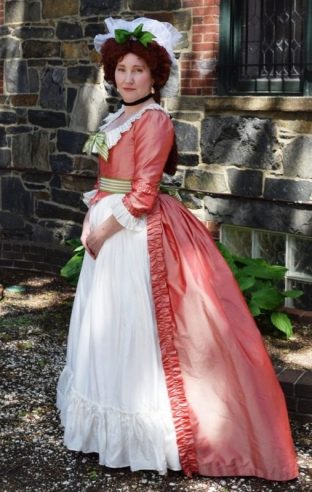

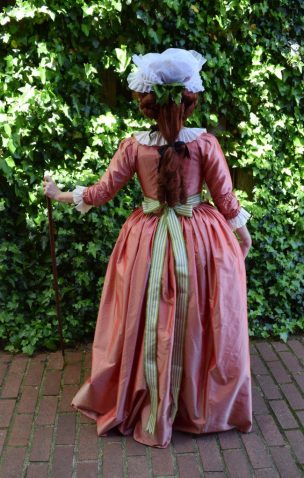
Gah I love it. I also love the “mood” photo, everything is green and pink and perfect. Such an interesting project!
LikeLiked by 1 person
I loved Seeing each step you took to turning your 1760 gown to a 1780’s. I was surprised that the original dress was a robe a l’anglais. With all the beautiful trimmings I would have thought it would have been a la’Francais. But seeing that made me happy because I wanted to make a similar type dress, but I thought it hade to be a sack back and I don’t have enough material to make that style. Also, I thought that all a’anglais hah closed fronts.
On a very different line of thought, you mentioned your master’s degree and your PhD thesis, which made me intrigued. What specifically are your degrees in and what schools offer them. I have a master’s in business, unfortunately it isn’t even close to historic customs but I am interested in seeing what that type would entail.
Again thank you for you informative blog! Fellow Dress Maker, Chris
LikeLike
This is fantastic! I absolutely love seeing this process in action. The ability to remake and piece is part of why 18th century sewing jazzes me so much. I find the utility fascinating. And, of course, both gowns are gorgeous!! Thanks for sharing!
Caroline
LikeLike
This is beautiful and what a great job you did. The color is gorgeous.
Marion
LikeLike
Congratulations on a terrific job. I love this and the colors,too. Thank you for sharing.
Marilyn
LikeLike
I dig the transformation and I kinda am super adoring the simplistic lines in the 1780s remix. It’s cool to see this level of experimental archaeology, thank you for documenting the process ❤
LikeLike
This has been an absolutely fascinating set of articles, thank you so much for sharing.
LikeLike
Ok, stupid question from a total n00b:
Is your sentence about the underpinnings (“split false rump in addition to the stays, rather than the pocket hoops worn for the 1760s”) true for all areas or only for some countries? If only for some: Which country are you speaking of?
I’m interested in fashion in France in the 1780s, so I need to make sure. ^ ^
Thanks in advance for answers.
LikeLike
Hi there! That’s a really great question, actually! I do tend to come at historical fashion/costuming from an Anglo/British perspective. However, France has really been the main fashion leader for many centuries. Both the gown styles and underpinings styles are examples of fashionable dress that more or less directly came from France, specifically Paris. And it wasn’t just Britain that was influenced but pretty well all of Europe and their colonies. During the late 18th century French fashion did take quite a bit of inspiration from English country fashions – the increased simplicity, for example – but even that was translated by the french and then re-exported back to England and beyond.
So, to sum up and directly answer your question – yes, these underpinnings apply to France in the 1780s – because they were probably the ones who started it in the first place! :oD
LikeLiked by 1 person
Thank you a lot for the answer.
While reading new questions came into my mind:
Which social classes wore what kind of underpinnings?
Were the ladies at court more traditional or more progressive than those of the bourgeoisie? What were the formal court dresses like? I know that Marie Antoinette wore the “Chemise á la Reine”, but did she and other high-ranking ladies wear more traditional dresses too?
Were pocket hoops or panniers still worn on some occassions or had they gone for good?’
Thanks again!
LikeLike
Hoo boy! That’s a lot of questions, not all of them with easy, straightforward answers. So I’m going to give really quick, basic answers and a couple suggestions for where else to find information. Note that my expertise is more anglo-oriented, so my answers may not all be 100% applicable/correct for France.
1. Re underpinnings. Stays were universal, women of all classes except for the very poorest wore stays, they were as much about respectability as they were fashion, if not more so. Skirt foundations such as pocket hoops/hoop petticoats and false rumps were probably worn mostly by the fashionable. This does not translate into neat and tidy social classes since it wasn’t always just the rich who were fashionable.
2. Ladies at court. Formal court dress was its own thing and tended to be fossilized versions of earlier, specifically 17th century, fashion. However, I’m unsure of the details of just when court gowns (robes de cour) were worn in France – I know it was different than in England. Outside of these occasions the class of people who would be at court would usually be wearing up-to-the-minute fashion. However, this does not necessarily mean they were more fashionable than all the bourgeoisie since wealthy merchants tended to get the newest thing first.
3. Formal court dresses. See #2 and also try pinterest or google image searches.
4.Marie Antoinette. Also relates to #2. When attending court she wore more formal court dress. When she wasn’t, and especially when she was at Petit Trianon she abandoned formal court dress – which is one of the reasons she went there so often, to escape what she felt was the stifling formality of the French court (she was Austrian, and their court was less formal, as was also the English court).
5. Pocket hoops/panniers. By 1780 they were pretty much right out of fashion. They fell from favour over the course of the 1770s. I *think* they were still part of the robe de cour and I know they were still part of English court dress (which was worn only to the most formal court occasions, whereas formal court dress was worn more often in France) but otherwise they were done.
You can easily find more in-depth information about all of this with google searches. And there are LOTS of books written about French fashion, for example:
“Queen of Fashion: What Marie Antoinette wore to the Revolution”
“Fashion Victims” Fashion at the court of Marie Antoinette” (or something like that) by Kimberly Chrisman-Campbell
the scholar Aileen Ribeiro has written lots on French fashion from various angles
And there’s lots, lots more that a very little digging will turn up.
LikeLike
Thank you again for your extensive answer.
I had already done some research on French 18th century clothing, but I didn’t dive down to details like underpinnings in certain decades yet. So I had wrong assumptions / impressions about some things. Particularly because all the minor or major changes over the entire century can be a bit much information for a beginner. ^ ^
You helped me clear it up a bit and get the pieces together.
LikeLike
It’s taken me a bit to get around to reading this series because I wanted to give it proper attention, and having finally read it I have to say: wow!
Thank you so much for doing this and sharing it with us in such detail. I love how experimental archaeology gives us potential answers to questions like why did the back waist get more pointy. I doubt we’d ever find that out without going through the process you did. I’m also amazed how quickly you managed to do the alterations!
I don’t think I’ve commented on your blog before, so I’ll add that the work you do is gorgeous and I love seeing what fantastic creations you come up with. It’s incredibly inspiring, thank you!
LikeLike
What a nifty set of hypotheses and testing of them. Your argument carried through convincingly — and it was so interesting to see how the alterations resulted in the marks so common on refurbished gowns. Your finding concerning the rump effect of the narrowed pleats is just plain cool. Betting you had a warm response at the conference. Thank you kindly for sharing your research!
Very best,
Natalie in KY
LikeLike
Pingback: Rest in Pieces: Remaking a Pink 18th Century Gown circa 1783
I am enjoying your blog posts a lot. I will be using one of your hat tutorials in the next few days to make a very tall 1780-90 hat! It’s a great and clear tutorial, but we’ll see if I can make it work. You mention your standalone tucker and ruffles can be transferred between dresses. Do you have a post on that? Or could you direct me to how exactly one makes that kind of ruffle (for sleeves and neck)? Also, do you baste them into the dress lining?
LikeLike